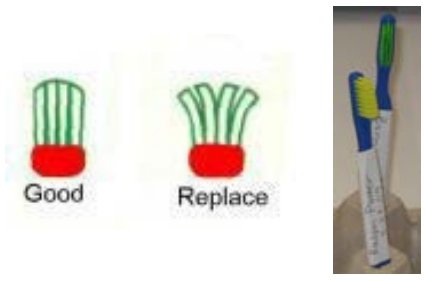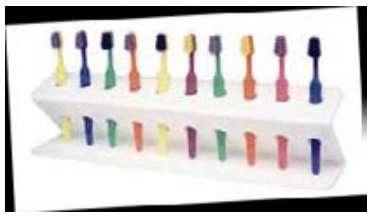Toothbrushing guidelines
Description
Tooth brushing in a centre environment supports consistent oral health messages and practises at home. Good oral hygiene practice should be established at an early stage in a child’s life and become an integral part of normal daily hygiene.
Fluoride toothpaste
Regular daily tooth brushing with a fluoride toothpaste twice a day is highly effective in preventing dental decay. Use of fluoride toothpaste in a centre environment includes: - Adult strength toothpaste provided, containing at least 1000 ppm (parts per million) fluoride, is used.
- A smear of toothpaste is used for all children under 5 years and a pea-size for over 5 years. (Image 1)
- Where toothpaste is shared, staff should put it onto a clean surface such as a plate or paper towel. (Image 2)
- There is enough spacing between the quantities of toothpaste to allow children to put it on their brush without cross-contamination.
- Toothpaste must only be given out at the time the child is ready to brush.
- Closely supervise children who have their own tubes of toothpaste to use.
- Staff should cover any cuts, abrasions or breaks in their skin with a waterproof dressing.
| /image1.PNG)
/image2.PNG)
|
Toothbrushes
The size and shape of a toothbrush is important for brushing a child’s teeth correctly. - Toothbrushes are the right size for the age and ability of the child.
- Toothbrushes are replaced once a term, or sooner if required (for example, when the bristles become splayed).
- Toothbrushes are individually identifiable for each child.
- For storage, see below.
|  |
Tooth brushing process
Key tips:
- Brush teeth for 2 minutes.
- Spit, don’t rinse after brushing.
- Advisable to have a mirror in front of children when brushing.
- Children need help with brushing their teeth until around the age of 7.
- Supervise children when brushing their teeth.
- Staff should stand behind the child while helping them brush their teeth.
- Tooth brushing takes place at a time which is most suitable for each centre.
- Children are discouraged from swallowing toothpaste during or after brushing their teeth.
- After tooth brushing, brushes are rinsed thoroughly and individually under cold running water and replaced in the storage system to allow them to air dry.
Storage systems for toothbrushes
Toothbrushes are a potential source of infection. Storage systems need to prevent cross-contamination. Toothbrushes need to be stored in appropriate storage systems. - Toothbrushes should stand in the upright position or in individual ventilated holders.
- Storage systems should allow sufficient distance between toothbrushes to avoid cross-contamination.
- Storage systems should display symbols that match with those on the children’s toothbrush so they can easily identify their toothbrush.
- Storage systems which do not have covers are stored within a specific trolley or in a clean, dry cupboard.
- Do not store toothbrushes in toilet areas, store away from children, at adult height or in a suitable trolley.
|  |
Cleaning of toothbrushes and storage systems
Appropriate cleaning procedures are in place to ensure that cross-contamination is reduced. Good cleaning practice should be an important part of a childcare setting.
- Manufacturers’ guidelines are followed when cleaning and maintaining storage systems, including dishwasher cleaning, where appropriate.
- Storage systems, trolleys and storage areas are cleaned, rinsed and dried at least once a week (more if soiled) by staff using warm water and soap.
- Care is taken to make sure toothbrushes do not cross-contaminate when being removed from or replaced in storage systems.
- To avoid cross-contamination from spit while tooth brushing, the storage system should not be placed directly beside the children while they brush their teeth.
- Storage systems are replaced if cracks, scratches or rough surfaces develop.
- Any toothbrushes dropped onto the floor are thrown out and replaced.
- Toothbrushes must not be soaked in bleach, other cleaner/disinfectant or placed in boiling water
- Tubes of toothpaste can be cleaned with a damp tissue.
Further information
For further information on toothbrushing, please visit Ministry of Health website or the Bee Healthy website, 5 tips to keep you smiling. You can also contact your Community Oral Health Service on 0800 TALK TEETH (0800 825 583).
Download printable factsheet